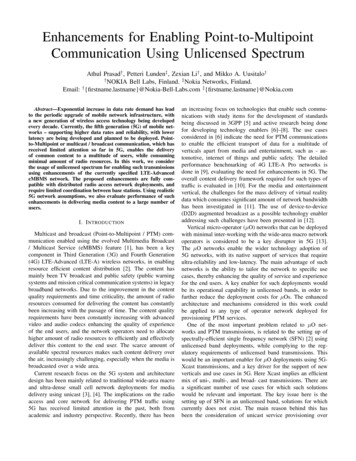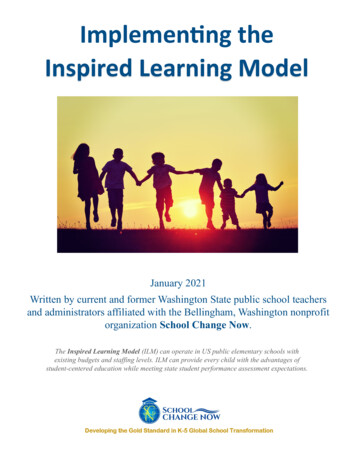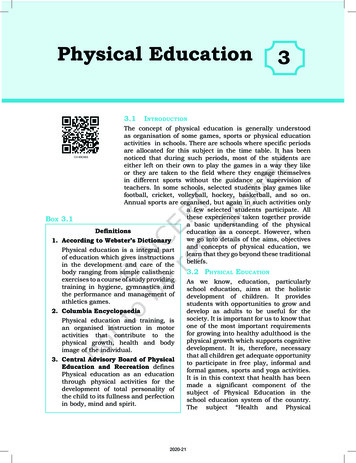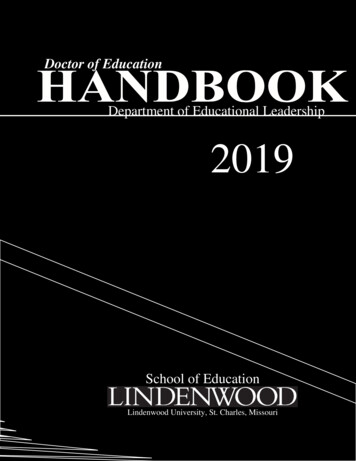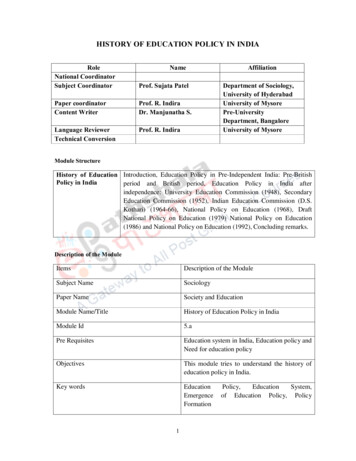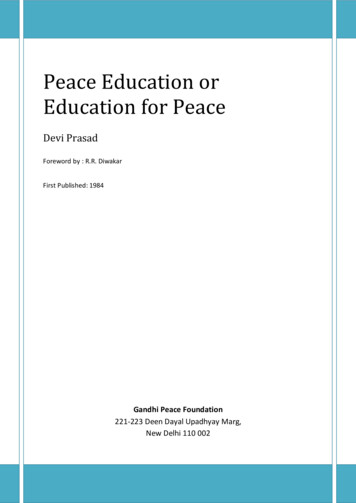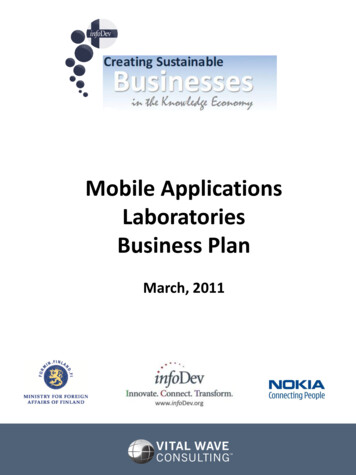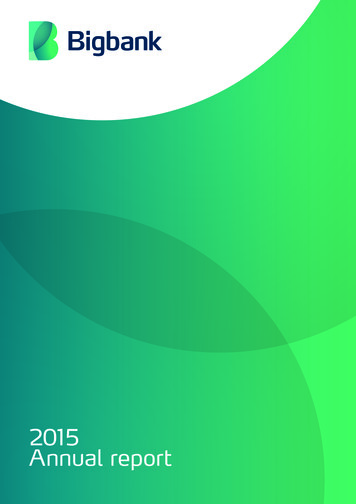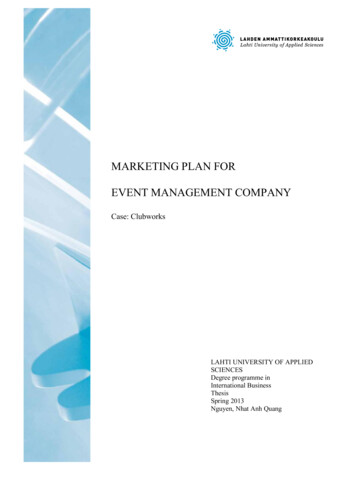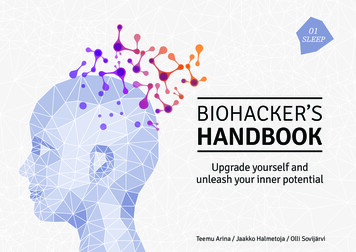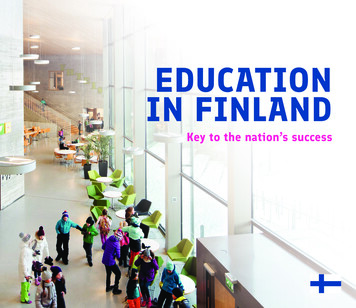
Transcription
EDUCATIONIN FINLANDKey to the nation’s success
Aalto UniversityDeveloping education to meet the challenges of today and the future is a central issuein the survival and success of humankind.Decision-makers and specialists around theworld are frantically seeking the best solutionsfor providing education. Their attention isincreasingly drawn to the education system ofFinland, which produces top results in international learning comparisons.One of the greatest strengths of education in Finland is that it offers everyone equalopportunities to study, regardless of socialand financial background. Instead of competition and comparison, basic education focuseson support and guidance for the pupils asindividuals.Teachers are highly trained, with university-level degrees. Their profession is held inhigh regard.Teaching small children focuses on theirinherent strengths and supports their sense ofsafety and the development of their emotional life and social skills. Teachers motivatepupils with encouragement. Performance isnot graded with numbers until later in schoolyears.After completing basic education incomprehensive school, everyone has the opportunity to continue general and professional education according to their interests andinclinations. Continuing to study is possiblein various forms throughout life. In Finland,education is free, from pre-primary level tohigher education and even further.The following pages describe how thisis done in Finland and what the philosophybehind Finnish education is.ContentO1The Finnish education system02Life-long learning03What is taught in Finnish schoolsand how?04Making it happen05Topical issues in Finnisheducation06Towards the futureWelcome to a Finnish school!Ministry for Foreign Affairs, 2017.Text: Salla KorpelaProduction: Otavamedia OMAPhotos: Visit Finland, Otavamedia,Ministry of Education and Culture,Ilari Nummi Novia UASIt all starts with schoolFreeEqualQualityEducationFor all
01. The Finnish education systemEDUCATION SYSTEM IN FINLAND8DOCTORAL DEGREESLICENCIATE DEGREESUniversities7MASTER’S DEGREESUniversities6BACHELOR’S DEGREESUniversitiesDuration in yearsMASTER’S DEGREESUniversities of Applied Sciences21–1.5Work experience 3 years3BACHELOR’S DEGREESUniversities of Applied SciencesEducation for everyone in all stages of life43-4standards as the public schools, their operationsare publicly funded and their admission of pupilsand students is based on the same principles. Theshare of all public funds spent on education is over11 per cent.Basic education lasts for nine years. What istaught at comprehensive school is guided by thenational core curriculum. Municipalities have theobligation to provide compulsory basic educationfor all children living in their area. There are alsoextensive learning and well-being support servicesfor those who need them. Basic education ispreceded by high-quality early childhood education and care, available to all.After comprehensive school, the young cancontinue in either vocational or upper secondaryeducation. The duration of both is approximatelythree years. Both lines offer general educationas well as extensive opportunities to study in ac-cordance with personal interests and inclinations.Over 76 per cent of Finns aged 20–24 have eitherpassed the matriculation examination or earneda vocational qualification (data from 2015). Bothqualify the student for studies at a university or auniversity of applied science.There are 14 universities and 25 universities ofapplied science in Finland. Approximately 41 percent of working-age Finns have higher education.The changing world and working life are addressedby providing opportunities to obtain continuingeducation and retraining in various stages of life.Opportunities are also available to increaseone’s knowledge and skills at institutes of adulteducation open to all, offering subjects rangingfrom languages to weaving and from informationtechnology to dancing.MATRICULATION EXAMINATIONGeneral upper secondary schoolsISCED-CLASSIFICATION 2011The high quality of the Finnish school systemis based on a clear national ethos that people are the nation’s most important asset.They have the right to receive excellent education,which will help maximise their potential to be whoand what they want to be.This philosophy has enabled Finland to risefrom one of the poorest countries in the world tothe height of technological expertise and becomeone of the world’s wealthiest countries in its 100years since independence. Over the decades, boldsolutions have allowed Finland to develop a systemthat gives the opportunity of life-long studying andself-development to everyone living here.In practice, all education is financed from taxrevenue. Private education markets offering superior education for money do not exist in practice.The few educational institutions run by privateorganisations adhere to the same objectives andWorkexperience33.5–4Specialist vocationalqualifications*LIBERAL ADULTEDUCATIONAdult educationcentres,Folk high schools,Summeruniversities,Study centres,SportsinstitutesFurther vocationalqualifications*VOCATIONAL QUALIFICATIONS*Vocational institutions*Also available as apprenticeship training3Voluntary additional year of basic education1-20BASIC EDUCATION7–16-year-oldsComprehensive schools9PRE-PRIMARY EDUCACION 6-year-olds1EARLY CHILDHOOD EDUCATION AND CARE0–60 Early childhood education, 1 Primary education, 2 Lower secondary education, 3 Upper secondary education,4 Post-secondary non-tertiary education, 6 Bachelor’s or equivalent, 7 Master’s or equivalent, 8 Doctoral or equivalent5
Early childhood education and carePre-primary educationPlay and care prepare childrenfor school02. Lifelong learningFinns have access to free educationthroughout their lives, beginning with preprimary education, up to the highest level atinstitutes of higher education. Various routesprovided in the Finnish education path aredescribed on the following pages.6Children in Finland start school relativelylate, at the age of seven. It is a nationalprinciple that children need time andspace to grow and develop. Finnish teaching takesadvantage of the sensitive periods of development and encourages children to think independently and be creative.During their early childhood, children can enjoy the nurturing and care provided by their parents while also benefitting from day care, wherethey can practice working in groups by playing,exercising and spending time outdoors. Parentsof small children are entitled to long family leaves.Families can choose between municipal or privateday care, either in small groups in the home of thecare provider or in a day care centre. Day carereceives considerable financial support from thestate, and day care charges are proportionate tothe incomes of families. The early education andcare services provided by municipalities havepedagogical objectives, and the competencerequirements of personnel are regulated by law.Day care teachers have university degrees.Six-year olds participate in pre-primary education, which prepares them for school and promotes their social skills and healthy self-esteem,either in a day care centre or school. Nationalstandards exist for the content of pre-primarycare. Municipalities have the obligation to providechildren with transport to and from school whereneeded.If necessary, a child’s readiness for school istested and he or she can start school a year earlieror later.7
cost to society of the school year of one Finnishpupil was 8,025 euros (US 8,519) in 2016.The pupils’ learning outcomes in comprehensive school are monitored by means of national assessments, in which approximately 5–10per cent of the age group participate throughrandom sampling.Basic education – common for all8Required knowledge and skillsUNIFORM TEACHING OBJECTIVESEThe Finnish government decides on the generalobjectives and the division of hours between thesubjects taught in early education, basic education and upper secondary education. Basedon the objectives, the Finnish National Agencyfor Education, subordinate to the Ministry ofEducation and Culture, decides on the nationalcore curriculum. The education providers, themajority of which are municipalities, base theirown curricula on the national core curriculum,ducation at school is compulsory for Finnish children and young people. Compul-The responsibility for providing basic education rests with municipalities, and therefore,sory education begins the year the childturns seven and ends when they have completedthe 9-year comprehensive school syllabus in fullor after ten years of compulsory education. Basiceducation is also available for adults, such asimmigrants.The objective of basic education is tosupport personal growth as individuals and asmembers of society as well as to teach importantknowledge and skills. Basic education provideseveryone with the same opportunities to pursuefurther studies, and is free of charge. All tools,supplies and materials used in teaching are alsocomprehensive schools are located where thereare families with children. The schools may be either joint schools with all nine grades in the samebuilding, or grades 1–6 and 7–9 in separateschool buildings. Small rural schools may have acouple of dozen pupils, while urban schools mayhave more than a thousand. Regardless of theschools’ size, the standard and level of teachingvary little by international standards. The qualifications of teachers are also uniform everywhere.The expenses of basic and upper secondaryeducation are included in the municipalities’budgets, although the government reimbursesfree for pupils.an average of 25 per cent of the expenses. TheLifelong learningNATIONWIDEand ultimately the schools prepare their ownindividual plans.This ensures that the level and scope ofteaching in the same subjects is the same forall school-goers across the country. However,the system does allow for local emphasis andadditions.FREE LUNCH FOR EVERY PUPILEach child and young person in Finland,from day care to upper secondary schooland vocational schools, receives a daily,healthy hot meal, including salad, milk orother beverage and bread.The free lunch is included in thecurriculum. The meal refreshes the pupilsand students, gives them energy and helpsthem stay alert for the remainder of theday. At the same time, the school lunchis an opportunity to teach children abouthealth, nutrition and good manners.Special diets are taken into consideration. An increasing number of schoolsoffer a vegetarian option, organic food andenvironmentally friendly food every day.Finland was the first country in theworld to provide schoolchildren with freelunches, in 1948.9
LET’S GO TOSCHOOL!Learning skills for the futuretogether in Metsokangas schoolAstately group of colourful buildings standsat the edge of a snowy forest in a suburb ofOulu. It is the Metsokangas comprehensiveschool, where more than 1,100 pupils aged 7–16 andapproximately one hundred teachers, special needsHe has been involved in designing the buildingsand planning the pedagogy of the school since thebeginning: the school opened in 2008 and is stillbeing expanded. The guiding principle of the schoolis communality, illustrated by the school motto: “Ourassistants and other adults work every day.Here, a couple of hundred kilometres from theArctic Circle, the school day on a cold January morningstarts an hour before the sun comes up over the horizon.However, Metsokangas pupils are not fazed: a majorityof them come to school from the nearby residential areaby bicycle all year round.Inside the building, the pupils leave their outdoorclothes and shoes in the hallway, and cheerful greetingsfill the air as they, teachers and other members of theschool community proceed to their classrooms andduties. The atmosphere is friendly and equal.“There is no way I can remember the names ofeverybody in this big a crowd, but I try to walk in thehallways to greet people,” says principal Kalle Komu-Metsokangas!”“We aim to teach the pupils not only basic skills butalso skills for the future: cooperation, discussion, independent thinking and self-direction,” Komulainen says.The school is increasingly moving teaching fromthe classroom out to the world and from books to theinformation highways. Project-based learning breaksdown barriers between different subjects and teachesto search, analyse and process information. All teachingincludes a focus on learning and actively using IT skills.“The role of the pupil has expanded from a learnerof information to a producer of information. The dutyof us teachers is to encourage them and provide a solidframework for a self-directed journey into the world,”Komulainen concludes.In Finland, school days areshorter than the OECD average,but they are spent efficiently.The amount of homework is alsosmall by international standards.lainen.10 Lifelong learning11
LET’S GO TOSCHOOL!The school day of Hilma Visuri, a fourth-graderOn a regular school day, ten-year-oldHilma Visuri wakes up at seven inthe morning and has breakfast athome. She splits her time living with her motherand father, each of whom lives near Hilma’sschool. The school day usually starts at 8:15 a.m.,sometimes even later, at 9:30 a.m. Hilma usuallybicycles to school.Hilma’s class studies in the newest buildingof the Metsokangas school, named Korpimetso,which was built in 2016. Instead of traditionalclassrooms, the building features four largeteaching modules of approximately 320 m2each. They house three or four teaching groups,their teachers and assistants – 100 peopleat most. The space is flexible and adaptable,making it possible to work in a variety of groupcompositions and situations and engage indifferent activities.The new kind of learning environment suitsHilma well.12Lifelong learning“The best thing is that you get to choosehow and where you study and that the space isnot confined,” she says.In Hilma’s class, the exercises for the weekare handed out on Mondays, and the pupilsthemselves can plan when and how theycomplete them. A large portion of school workis carried out in groups and as projects. Theplanning of the exercises and the division intosmall groups take into consideration the pupils’personal prerequisites and inclinations.The atmosphere in the multi-functionalspace is that of focus and motivation; one groupis searching for information on the countries inEurope on a computer while another is learningEnglish verbs with a teacher. A few small groupsare playing learning games and the rest areconcentrating on reading. If any student needsspecial attention or things start getting restless inthe room, an available teacher or assistant intervenes. Soundproof spatial elements can be usedto create quiet nooks for more private studying,if needed. Hilma’s favourite subjects are arts andcrafts, for which the module is equipped with adamp-proof space.The lessons at Metsokangas school last60 minutes, and there is a 15-minute recess inbetween. The lunch break is longer. The childrenspend recesses outdoors and are also allowed toventure into the woods nearby.Hilma’s school day is usually over by 1:30p.m. at the latest. She goes back home on herown, usually by bicycle. At home, she has asnack and does her homework, which usuallytakes about 10 minutes, sometimes longer. During her free time, Hilma plays with her friendsand takes dance lessons three times per week.Usually her mother or father takes her to thelessons, sometimes she goes by bus.“When I grow up, I’d like to be a fashiondesigner or an actress,” Hilma says.13
Secondary educationIndividual paths to professional skillsA14fter completing comprehensive school,slightly less than half of the age groupwill continue studies in the uppersecondary school and slightly over half will takeup vocational studies. Approximately five percent of pupils who complete comprehensiveschool will not continue studies. For them, careerguidance is available. The goal is that aftercomprehensive school, everyone should obtainat least a secondary education degree, in otherwords, complete a matriculation examination ora vocational upper secondary qualification.Both upper secondary school and vocationaleducation, including school lunches, are free ofcharge, regardless of whether the educationalinstitution is owned by the municipality, state,or a private education provider. The studentsneed to purchase their own textbooks and othersupplies. Students can receive financial aid fromsystem of various social benefits and well-beingsupport services.the government and have access to an extensiveThe studies are organised in courses andLifelong learningUPPER SECONDARY SCHOOL ANDMATRICULATION EXAMINATIONIn upper secondary school, obtaining more indepth general education continues and studentsstart familiarising themselves with academic content. The comprehensive school-leaving certificate is used when applying to upper secondaryschool. Each upper secondary school studentstudies their mother tongue, the other nationallanguage and at least one foreign language,mathematics and science, humanities and socialsubjects, religion or ethics as well as physicaleducation, arts and crafts. In addition to thesubjects compulsory for all, students have a fairlywide freedom of choice and, if they so wish, theycan study optional subjects in greater depth.last 2–4 years, depending on the student’s ownchoices. The curricula of some upper secondaryschools have a special emphasis, for example, onmusic, sports or visual arts. In addition to academicskills, the application criteria in these schoolsinclude the applicant’s hobbies and interests anddemonstration of skills.The upper secondary school studies culminatein the national matriculation examination, whichprovides eligibility for studies at higher educationinstitutes. The examination is organised everyspring and autumn. Each candidate must take testsin their mother tongue, literature, and a minimumof three optional subjects: the second nationallanguage, a foreign language and mathematics orthe humanities and natural sciences. The examination can be spread over several of the biannualexamination sessions.In the Finnish education system, the matriculation examination is the only national examinationthat assesses the skills and maturity of all studentson a nationwide basis.VOCATIONAL EDUCATION ANDQUALIFICATIONSVocational basic education provides students withthe basic knowledge and preparedness to workin a vocation as well as important knowledge andskills for further studies, hobbies and personaldevelopment. Vocational studies can begineither directly after comprehensive school, aftercompleting upper secondary education, or duringworking life. Those who have earned a vocationalqualification can continue studies in universitiesand in universities of applied science.Vocational basic education is provided inseveral sectors and by a variety of providers: invocational schools, folk high schools, throughapprenticeship training or on-the-job learning.The duration of studies is usually 2–4 years anddepends on the student’s educational background,among other things. Students can also demonstrate their competence by means of various qualifications, which may also be competence-basedqualifications.DUAL QUALIFICATION ANDPERSONALISED STUDY PATHSIn many municipalities, students have the opportunity to complete both upper secondary schooland their choice of vocational studies at thesame time. At the end of the combined studies,which last 3–4 years, they will complete boththe matriculation examination and a vocationalqualification. Those studying for a vocation mayalso design a personalised study path themselvesand include modules offered by different schoolsin their studies.15
Higher educationAcademic and practical studies ata higher levelA Aalto Universityfter completing their secondaryeducation, students can continuestudying at a university or a university of applied science. Applications to theseare submitted primarily through the jointapplication system, and student selection isbased either on the upper secondary certificate, an entrance examination, an aptitudetest or a combination of these.UNIVERSITIES OF APPLIEDSCIENCE/TECHNOLOGY Novia UASThese offer practical studies requiringhigh-level competence. The degrees that canbe earned include, among others, businessadministration, engineering, informationtechnology, social services, culture and arts,and nursing.Studies at universities of applied sciencelast 3–4½ years and include a practice periodof one semester. After completing the Bachelor’s degree, those who have at least threeyears of employment experience can applyto a Master’s programme. Studying full-timeit takes 1-1½ years to complete the Master’sdegree. When certain conditions are met,the studies can lead to additional, scientificstudies in a university.16Lifelong learningUNIVERSITIESThe universities of Finland represent all fields ofscience and arts, and the network of universitiescovers the entire country. The oldest and largestis the University of Helsinki, which was founded in 1640 and today has more than 34,000students. In international comparisons, the University of Helsinki has repeatedly ranked amongthe 100 best universities in the world.In most fields, students first complete aBachelor’s degree, which takes approximatelythree years, and then pursue the Master’s degree, usually complete in two years.Those who have completed a Master’sdegree at a university or university of applied science may apply for further studies at a universityto pursue a licentiate or a doctoral degree. Universities also offer adult education and a varietyof research and consulting services.FINANCIAL AND SOCIAL SUPPORT FORSTUDIESStudies in higher education are free for Finnishcitizens and citizens of the EU/EEA countries.Under certain conditions, the students haveaccess to financial aid, subsidised housing services, affordable meals, discounts on local publictransport, health care services, and other supportservices.HIGHLY EDUCATED FINNSFinland has a total of 14 universitiesand 25 universities of applied science,which prepare students for tasksrequiring high vocational skills.Currently, approximately 40 per centof the age group of 30–34-year-oldFinns has earned a higher educationdegree.RovaniemiOuluUniversities in FinlandUNIVERSITY CITY1. Aalto University2. University of Helsinki3. University of the Arts Helsinki4. Hanken School of Economics5. University of Turku6. Åbo Akademi University7. Tampere University of Technology8. University of Tampere9. University of Eastern Finland10. Lappeenranta University of Technology11. University of Jyväskylä12. University of Vaasa13. University of Oulu14. University of LaplandHelsinkiHelsinkiHelsinkiHelsinki, VaasaTurkuTurkuTampereTampereJoensuu, Kuopio, peenrantaTurkuHelsinki17
Opportunities for allDeveloping skills and knowledgeIn Finland, everyone has the opportunity toeducate and develop themselves and obtain newskills and hobbies, either free of charge or at alow cost.BASIC EDUCATION IN THE ARTS FORCHILDREN AND THE YOUNGA basic education in the arts provides studentswith skills to express themselves and to pursuevocational and higher education in their selectedfield of art after sufficient basic studies. Thebasic education is provided by nearly 400 musicinstitutes as well as schools for visual arts, dance,drama, literary art, and crafts and design. Teaching in these institutions has fixed objectives andstudies advance from one level to the next. Families of students pay a term fee, but most of theexpenses of the institutions are covered by thegovernment and municipalities. Approximately12 per cent of all children and young people inFinland participate in basic education in the arts.LIBERAL ADULT EDUCATIONNearly all municipalities have at least one educational institution offering liberal adult education,18Lifelong learningsupported by society. Liberal adult education haslong traditions – the first folk high school was established even before the end of the 19th century.Liberal adult education is available for anyone,and the cost is usually a few dozen euros percourse to study subjects such as foreign languages,photography, guitar playing, etc., at adult educationcentres in one’s hometown. In the summer, diversepractical and academic studies are available insummer universities and folk high schools. Folk highschools organise one-year studies for those whoare trying to decide what vocation would best suitthem and who are taking a break after completingbasic or secondary education.The purpose of liberal adult education is to support diverse personal development and the abilityof individuals to function in a community, as wellas to promote democracy, equality and diversity inFinnish society.The educational institutions themselves decideon the contents of liberal adult education, and thestudies do not lead to a degree. The communitiesrunning the institutions may hold a variety of ideological or religious views or be based on local andregional educational needs.19
03. What is taught in Finnish schools and how?COMPREHENSIVE SCHOOLSUBJECTS COMMON TO ALL:BiologyGeographyPhysicsChemistryHealth educationReligion or ethics**HistorySocial studiesMusicVisual artsOut of the classroom and into the worldThe national core curriculum for basic education,implemented in 2016, emphasises the developmentof learning environments. In addition to a traditionalclassroom, teaching and studying are increasingly moving toenvironments outside the school: lessons are given outdoorsand excursions are made to museums, companies, and soon. Games and other virtual environments are also amongthe learning environments. The importance of technology isincreasing in the daily activities of schools. Diverse methodsare used in the teaching of all subjects.PROBLEM-ORIENTED LEARNING, INTERACTIONAND RESPONSIBILITY-TAKINGThe curriculum highlights extensive and transversal competence as well as interaction and expression skills. Children andyoung people are shown how to take responsibility for theirstudies, and they set goals, solve problems and assess their20CraftsPhysical educationprogress towards the goals. Personal experiences, emotions,interests and interaction with others contribute to creating afoundation for learning. The teacher guides pupils to becomelife-long learners. Education also pays attention to everydaylife skills and the pupils’ ability to take care of themselves.MULTILITERACY AND ACTIVE CITIZENSHIPTraditional text literacy has expanded into multiliteracy, whichmeans the ability to produce and interpret information indifferent formats, environments and situations as well as bymeans of different tools verbally, graphically, auditively andkinesthetically. This helps pupils understand the changingworld around them and to perceive its cultural diversity.Multiliteracy supports the development of critical thinkingand learning and is strongly linked to ICT skills.Basic education also provides pupils with working lifeskills and coaches them to become entrepreneurs and toparticipate in and influence society.Home economicsMother tongue and literatureThe other national language(Finnish or Swedish)*Foreign languageMathematicsEnvironmental studies*) Finland is a bilingual country whereFinnish and Swedish are the officiallanguages. Finnish-speaking pupils learnSwedish as the other national language andSwedish-speaking pupils learn Finnish.**) As a rule, pupils in comprehensiveschool receive teaching in their ownreligion, or if they do not belong to anyreligious community, they receive teachingin ethics.The pupils can also choose electivesubjects, including additional languagestudies, artistic and practical studies orother courses offered by the school.21
04. Making it happenWhat’s our secret?The success of the Finnish education system is based on cultural characteristicsand national solutions, which ensure thehigh quality of education every day.EDUCATION IS A NATIONAL PRIORITYEducation is highly valued in Finland, and thenation strongly believes in the importance ofeducation as the primary driver of the country’ssuccess. Trust in education and the power ofknowledge are still part of the nation’s selfperception and identity. Education is alsoseen as a central way to address the challengecreated by globalisation. This is implementednot only in basic education but also at its otherlevels.HIGHER EDUCATION OF TEACHERSComprehensive school teachers must have aMaster’s degree. At grades 1–6, class teachersteach all subjects, as a rule. They usually holda Master of Arts degree in education, withemphasis on pedagogical skills. At grades 7–9of comprehensive school and in the uppersecondary school, subject-specific teachingis provided by teachers who have a Master’sdegree in the subject in question and havecompleted pedagogy studies.Teacher training is very popular andthe field is highly respected. The number ofcandidates who apply to teacher training is fivetime higher than the actual intake.strengths of their pupils and, on the other,respect the common objectives.High-quality learning materials are animportant factor in practical school work.Despite the fact that the linguistic area ofFinnish is small and of the Swedish-speakingminority is even smaller, the production oftextbooks and other learning materials isstrongly emphasized. Materials are increasinglyavailable in electronic form and online.TEACHERS CAN CHOOSE THEIRTEACHING METHODSThe principle of local schooling means thatnearly all children and young people goto the school that is closest to their home.This prevents the differentiation of schoolsaccording to the social status of families.Since the schools maintain a reliably highstandard, parents are generally satisfied with theThe national curricula must be followed, butteachers have the freedom to choose theirteaching m
pedagogical objectives, and the competence requirements of personnel are regulated by law. Day care teachers have university degrees. Six-year olds participate in pre-primary edu-cation, which prepares them for school and pro-motes their social skills and healthy sel
